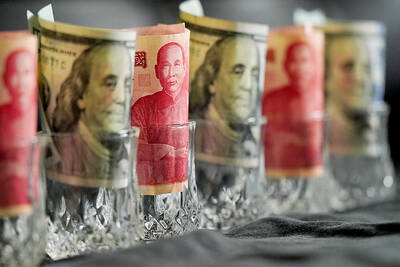World stocks on Tuesday closed out a notably profitable year, with Wall Street recording its best annual performances since 2013, boosted by hopes for a US-China trade deal.
New York rallied into the close, turning positive for the day and leaving the broad-based S&P 500 and tech-heavy NASDAQ Composite up 29 percent and 35 percent respectively for last year, the best showings in six years.
Key European markets showed increases of 25 percent or more for last year, partly thanks to late surges on receding recession fears and easing China-US trade tensions.
However, Brexit-hit London trailed its peers with a 12 percent annual rise, less than half the percentage increase managed by Paris, Frankfurt and Milan.
Earlier on Tuesday as US markets were about to open, US President Donald Trump tweeted that a partial trade deal with China would be signed in Washington on Jan. 15, ending some of the uncertainty about efforts to cement the deal announced early last month.
Prudential Financial Inc market strategist Quincy Krosby told reporters that the US-China detente could help decide the direction of the global economy next year.
“Much of the enthusiasm in the market is based on the idea that global growth is going to begin to accelerate, albeit slowly,” she said. “The question will be: Do we actually see positive growth, especially in China?”
Demand in China is crucial to chances for growth in global trade, while a China trade agreement could see US corporations begin investing again after a year when corporate capital spending stagnated worryingly, Krosby said.
Asian stock markets closed mainly lower on Tuesday, with Hong Kong’s Hang Seng Index ending a half-day of trading almost 0.5 percent down, although it rallied more than 7 percent last month. Tokyo was shut for a public holiday.
“While market volumes are predictably light, investors continue to strike a year-end cautionary tone as December optimism is gradually giving way to 2020’s uncertainty,” AxiTrader Ltd chief Asia market strategist Stephen Innes said in a client note.
Asian investors were also watching for significant policy announcements early in the New Year.
In a New Year’s speech yesterday, North Korean leader Kim Jong-un struck a decisively militaristic tone, warning of a new strategic weapon and “shocking” action.
Analysts said all eyes were on nuclear-armed Pyongyang’s threat of a “new way” after its end-of-year deadline for sanctions relief from the US expired.
An address by Chinese President Xi Jinping (習近平) would be followed closely.
Elsewhere on Tuesday, oil prices slid, despite reports that Iran had seized a vessel suspected of smuggling fuel near the Strait of Hormuz — a chokepoint for one-third of the world’s seaborne oil.
Over the year, the price of Brent North Sea crude jumped by almost one-quarter and the New York benchmark contract West Texas Intermediate soared more than one-third in value, helped by tighter supply.

The US dollar was trading at NT$29.7 at 10am today on the Taipei Foreign Exchange, as the New Taiwan dollar gained NT$1.364 from the previous close last week. The NT dollar continued to rise today, after surging 3.07 percent on Friday. After opening at NT$30.91, the NT dollar gained more than NT$1 in just 15 minutes, briefly passing the NT$30 mark. Before the US Department of the Treasury's semi-annual currency report came out, expectations that the NT dollar would keep rising were already building. The NT dollar on Friday closed at NT$31.064, up by NT$0.953 — a 3.07 percent single-day gain. Today,

‘SHORT TERM’: The local currency would likely remain strong in the near term, driven by anticipated US trade pressure, capital inflows and expectations of a US Fed rate cut The US dollar is expected to fall below NT$30 in the near term, as traders anticipate increased pressure from Washington for Taiwan to allow the New Taiwan dollar to appreciate, Cathay United Bank (國泰世華銀行) chief economist Lin Chi-chao (林啟超) said. Following a sharp drop in the greenback against the NT dollar on Friday, Lin told the Central News Agency that the local currency is likely to remain strong in the short term, driven in part by market psychology surrounding anticipated US policy pressure. On Friday, the US dollar fell NT$0.953, or 3.07 percent, closing at NT$31.064 — its lowest level since Jan.

The Financial Supervisory Commission (FSC) yesterday met with some of the nation’s largest insurance companies as a skyrocketing New Taiwan dollar piles pressure on their hundreds of billions of dollars in US bond investments. The commission has asked some life insurance firms, among the biggest Asian holders of US debt, to discuss how the rapidly strengthening NT dollar has impacted their operations, people familiar with the matter said. The meeting took place as the NT dollar jumped as much as 5 percent yesterday, its biggest intraday gain in more than three decades. The local currency surged as exporters rushed to

PRESSURE EXPECTED: The appreciation of the NT dollar reflected expectations that Washington would press Taiwan to boost its currency against the US dollar, dealers said Taiwan’s export-oriented semiconductor and auto part manufacturers are expecting their margins to be affected by large foreign exchange losses as the New Taiwan dollar continued to appreciate sharply against the US dollar yesterday. Among major semiconductor manufacturers, ASE Technology Holding Co (日月光), the world’s largest integrated circuit (IC) packaging and testing services provider, said that whenever the NT dollar rises NT$1 against the greenback, its gross margin is cut by about 1.5 percent. The NT dollar traded as strong as NT$29.59 per US dollar before trimming gains to close NT$0.919, or 2.96 percent, higher at NT$30.145 yesterday in Taipei trading